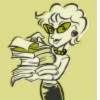 Gibbons, Gail. 2007. SNAKES. New York: Holiday House. ISBN 0-8234-2122-8
Gibbons, Gail. 2007. SNAKES. New York: Holiday House. ISBN 0-8234-2122-8Historically, snakes have been seen as gods and symbols of health. But today, the mention of snakes makes many people’s skin crawl—even though most of the 3,000 kinds of snakes are harmless to humans. Gibbons hits yet another homerun with this accurate, well-organized, and informative book on snakes. Though somewhat cartoonish, Gibbons illustrations are accurate and labeled with the name and geographic region of each snake. A color-coded world map highlights the areas which snakes inhabit. The short text blocks include easy-to-read sentences which are supported by the corresponding pictures. This style facilitates reader comprehension. Gibbons’ use of complete sentences in her captions also models proper writing form. Specific information in this book is easily found by using the bold, consistently located headings. In order to share tidbits about snakes which did not fit into a heading, a fact page is included. There is neither an additional resources section nor a bibliography in SNAKES. This leads the reader to independent research, though a few hints would have been nice.
This informational resource on snakes is recommended for readers ages 5-10.

No comments:
Post a Comment